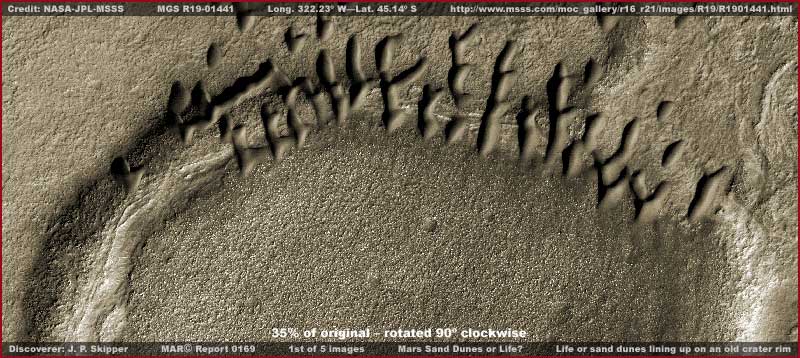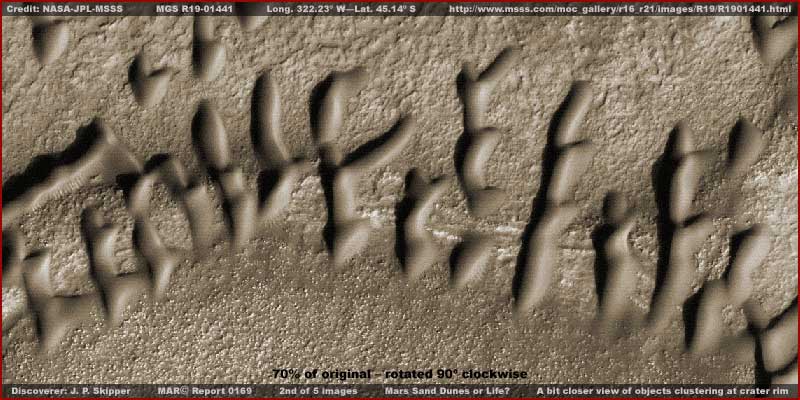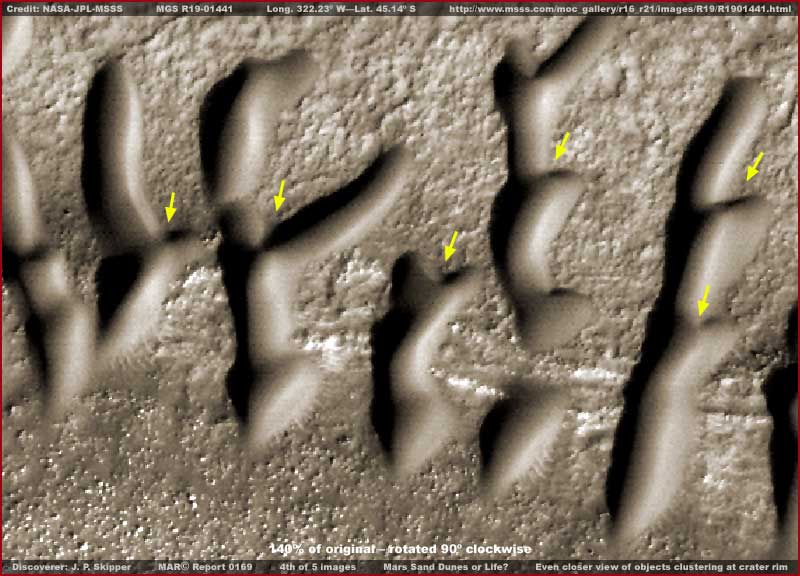
MARS SAND DUNES OR LIFE?
Report #169
September 13, 2009

This report is not meant to be definitive
on its own but additive evidence wise in relation to older as well as future
reports on this particular type of evidence subject matter. That subject matter
is evidence that the official consensus labels as sand dunes on Mars regardless
of how that evidence behaves or how it is visually configured in the environment
of this distant world.
For example, in the above first report image, I've reduced the strip size
down to 35% of the original and rotated the strip 90º clockwise to achieve
this wide-angle context view that includes an old crater rim and the "dunes"
evidence collecting along that rim. The image is from one side edge of the
strip to the other side. Since I am starting out with this rotated orientation,
I will maintain it throughout this report for consistency. Note how the objects
cluster in a line along the crater rim but do not move down past it into the
crater interior. These have officially been identified as "dunes"
as usual evidenced at this MSSS LINK-1.
However, note that I did not take my imaging from that particular link source
and that source appears to have the image flipped horizontally from the science
data straight .gif source here at MSSS LINK-2.
So don't get confused about this.

The above second image provides a bit
closer view of the same scene with most of the "dunes" evidence
still included within it. In the first and second closer but still context
image, note the terrain. Note that this relatively rocky but level terrain
appears to be devoid of any loose sand particulate sufficient to have fed
and enable sand dune formations. You should know that this is very typical
of this type of evidence that is officially referred to as "dunes."
Not only does this so well defined evidence not look very much like dunes,
where is there evidence of the forces and materials that needs to be present
to have brought them into existence?
For example, there is clearly insufficient sand presence in this terrain to
have formed these objects. Did you say it has all blown away leaving these
harder resisting cores behind? If so, where are the trailing particulate streams
in the terrain on the lee side of these objects or piling up against other
objects? Note how clean, smooth, and sharply defined they are. It's a clue.
Now admittedly if one searches in a widening radius out from this particular
image strip site in other strips, one will eventually come to evidence that
looks much more like dunes than the above. This much more sand dune looking
evidence is typically within deeper craters and confined to them. On the other
hand, these "dunes" in this image strip have fairly sharply defined
perimeters but beyond them in the terrain we are into rocky surfaces again
with little or no evidence of loose sand particulate that might have helped
form sand dunes. Remember, the absence of evidence is just as important as
evidence that is present.

The above third image moves the view in
a bit closer. Note how well and tightly defined most of this evidence is and
how similar the patterns are from one to another. These objects just do not
appear or behave as sand dunes would being shaped by wind forces as sand dunes
here on Earth are. Not wind shaped you say? If not, then what other natural
forces could shape natural sand geology into such smooth similar appearing
forms and yet leave no trace of blown away material in the terrain?
On the other hand, note the object pointed out by the yellow arrow in the
image's upper left corner. Note its pointed shape on the "front"
and the "V" concave shape in the "rear." This is a general
shape that many of the so called "dunes" evidence often takes in
the terrain among a number of others and all evenly spaced out one from another.
I have seen this evidence shape in multitudes out in open Mars terrain not
confined within craters and all oriented in the same direction. It many times
has many dark streaks confined within their perimeter and at other times is
either very dark and dull and sunlight absorbing or very bright and much more
sunlight reflective and hard surface looking similar to how the evidence appears
here.
I'm speculating that most of this type of evidence is some organic life form
that is likely colony life of some kind. I suspect that some forms of it can
move and is therefore a colony life that is mobile across terrain to some
degree. On the other hand, rarely do I see any evidence that could be interpreted
as such a large bulky moving form leaving a path identifying its passage.
Likewise, on the other hand, it always seems to exists on level but rough
rocky terrain where such passage might be obscured. Also, it rarely exists
where other Mars life forms have an established presence.

The above fourth image provides a yet
closer view of some of the evidence. Note that the yellow arrows now point
out what could have formerly been a concave "V" shape in the "rear"
of some of these formations that is now badly distorted by bloating growth.
Are these forms feeding on something in the ground and bloating up and becoming
larger due to what they are ingesting? Is the single wedge shaped object pointed
out by the single yellow arrow in the third image just a newcomer approaching
but has not yet settled in to the feeding and growth pattern?
If any of these questions have any merit, then the front of these objects
that are bringing up the rear may also be plugging into the rear of others
who are laying across the crater rim and feeding just within the crater without
moving fully into the crater interior. When plugged in to others they may
share in the feeding bonanza. In fact, there may even be a sexual reproductive
component in what we are looking at here triggered by resource plenty. The
food resource availability just over the rim in the old shallow crater may
explain much including why all this evidence is oriented in the same direction.

In the above fifth and final image providing
an even closer view before blur begins to be too much of a factor, note the
areas on the objects pointed out with the yellow arrows. Is this ribbing system
evidence of a secure attachment to the ground just inside the crater rim and
evidence of a portion of the main feeding system? I suspect so but this too
is of course speculation.
Now note the object evidence vertically along the right side of the above
5th image where the word "separation"
appears in the image. There appears to have been a possible separation of
the body back over the crater rim from the "feeding" portion just
inside the crater rim. One has to wonder if this was a planned disconnect
separation with the rear section now attempting to form a new feeding part?
If so, this may be evidence of reproduction in the presence of plentiful food
resource. Note how the separation point on the front of the rear body appears
to be forming into the same shape as the feeding portion of the other objects.
I find that fascinating!
Regardless of these observations and resulting speculation, note that this
very well and tightly defined evidence simply does not look like sand dune
geology nor is there any loose sand particulate in the immediate surrounding
terrain that might support a sand dune geology concept. Further, via more
careful observation, this evidence seems to demonstrate changing behavior
that is more characteristic of active life and not inanimate soil geology.
You must decide for yourself which concept you think has the most merit with
this amorphous shaped evidence, inanimate geology or life. With just distant
visual evidence and such an unfamiliar appearance, any conclusion reached
can't really be conclusive. Still you should at least be aware that this evidence
not only exists but may demonstrate behavioral patterns when viewed across
a broad variety of such evidence of which what you see here is only a tiny
part of.
We must always remember that this is a different world with its own unique
evolutionary path. Some of the evidence from this distant world can logically
be expected to be strange to our personal experience, unfamiliar to the Earth
human eye, and therefore difficult to grasp. This evidence's potential typifies
that concept.
DOCUMENTATION
http://www.msss.com/moc_gallery/r16_r21/images/R19/R1901441.html:
This link takes you to the MGS MOC R19-01441
official science data strip that all of my report images here were sourced
from. Note that the first and second listed angled strips have a different
horizontal orientation than the straight third and fourth listed strips. My
images here were sourced from the fourth listed straight .gif strip and then
rotated 90º clockwise to achieve the orientation in this reporting.
, Investigator
![]()